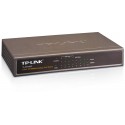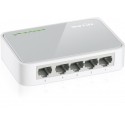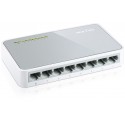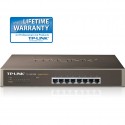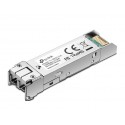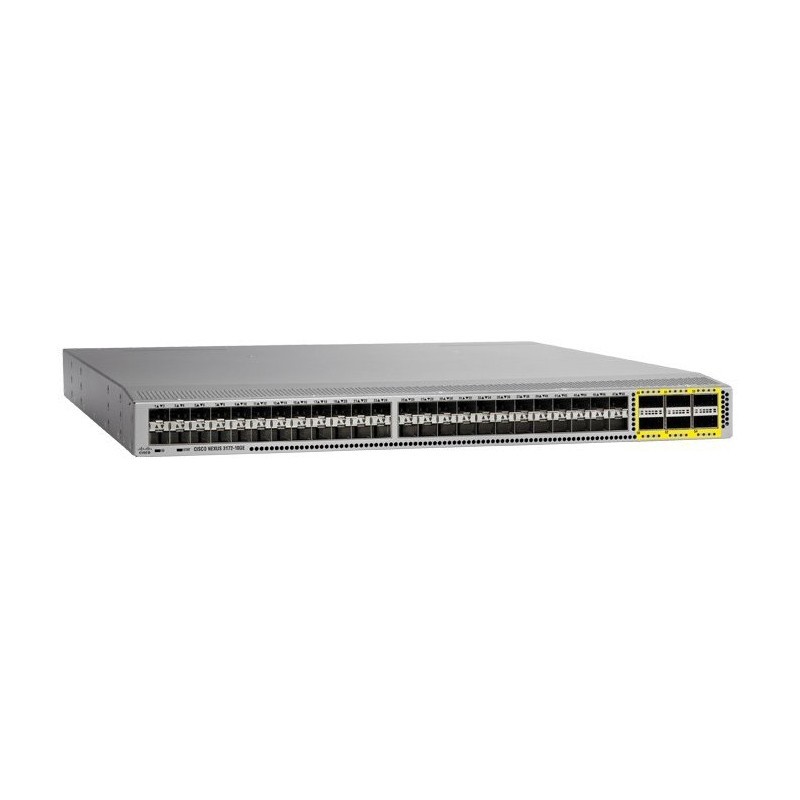
Product Overview
The Cisco Nexus 3172PQ, 3172TQ, 3172TQ-32T, 3172PQ-XL, and 3172TQ-XL Switches are dense, high-performance, 10- and 40-Gbps Layer 2 and 3 switches that are members of the Cisco Nexus 3100 switch platform. All switches offer improved port density and scalability in compact one-rack-unit (1RU) form factors. The Cisco Nexus 3172 switches run the industry-leading Cisco NX-OS Software operating system, which helps ensure continuous availability and sets the standard for mission-critical data center environments. They are well suited for data centers that require cost-effective, power-efficient line-rate Layer 2 and 3 top-of-rack (ToR) switches. These switches also support forward and reverse airflow (port-side exhaust and port-side intake) schemes with AC and DC power inputs.
The Cisco Nexus 3172PQ is a 10-Gbps Enhanced Small Form-Factor Pluggable (SFP+)–based ToR switch with 48 SFP+ ports and 6 Quad SFP+ (QSFP+) ports. Each SFP+ port can operate in 100-Mbps, 1‑Gbps, or 10-Gbps mode, and each QSFP+ port can operate in native 40-Gbps or 4 x 10-Gbps mode. This switch is a true phy-less switch that is optimized for low latency and low power consumption. The Cisco Nexus 3172PQ-XL are minor hardware revision of the Cisco Nexus 3172PQ. Enhancements include an additional 4 GB of memory (for a total of 8 GB). The additional memory allows users to perform object-model programming. The Cisco Nexus 3172PQ-XL also have 2.5-GHz CPUs.
Main Benefits
Wire-rate Layer 2 and 3 switching on all 72 10 Gigabit Ethernet ports:
- The Cisco Nexus 3172 switches provide Layer 2 and 3 switching of up to 1.4 terabits per second (Tbps) and up to 1 billion packets per second (bpps) in a compact 1RU form factor.
High availability:
- Virtual port-channel (vPC) technology provides Layer 2 multipathing through the elimination of Spanning Tree Protocol. It also enables fully utilized bisectional bandwidth and simplified Layer 2 logical topologies without the need to change the existing management and deployment models.
- The 64-way equal-cost multipath (ECMP) routing enables the use of Layer 3 fat-tree designs and allows organizations to prevent network bottlenecks, increase resiliency, and add capacity with little network disruption.
- Advanced reboot capabilities are included through In Service Software Upgrade (ISSU) and Fast Reboot capabilities.
- Power-supply units (PSUs) and fans are hot swappable.
High performance:
- The Cisco Nexus 3172 switches deliver ultra-low nominal latency, which allows customers to implement high‑performance infrastructure for high-frequency trading (HFT) workloads.
Purpose-built on the NX-OS operating system with comprehensive, proven innovations:
- Power-on auto provisioning (POAP) enables touchless bootup and configuration of the switch, drastically reducing provisioning time.
- Cisco Embedded Event Manager (EEM) and Python scripting enable automation and remote operations in the data center.
- Advanced buffer monitoring reports real-time buffer use per port and per queue, which allows organizations to monitor traffic bursts and application traffic patterns.
- Ethanalyzer is a built-in packet analyzer for monitoring and troubleshooting control-plane traffic and is based on the popular Wireshark open-source network protocol analyzer.
- Precision Time Protocol (PTP; IEEE 1588) provides accurate clock synchronization and improved data correlation with network captures and system events.
- Complete Layer 3 unicast and multicast routing protocol suites are supported, including Border Gateway Protocol (BGP), Open Shortest Path First (OSPF), Enhanced Interior Gateway Routing Protocol (EIGRP), Routing Information Protocol Version 2 (RIPv2), Protocol-Independent Multicast sparse mode (PIM-SM), Source-Specific Multicast (SSM), and Multicast Source Discovery Protocol (MSDP).
Network traffic monitoring with Cisco Nexus Data Broker:
- Build simple, scalable and cost-effective network test access point (TAP) or Cisco Switched Port Analyzer (SPAN) aggregation for network traffic monitoring and analysis.
Configuration:
The Cisco Nexus 3172 switches have the following configurations:
- 48 fixed 10 Gigabit Ethernet SFP+ ports (can operate at 100-Mbps, 1-Gbps, and 10-Gbps speeds)
- 6 fixed QSFP+ ports (each QSFP+ port can support 4 x 10 Gigabit Ethernet or 40 Gigabit Ethernet)
- Locator LED
- Dual redundant power supplies
- Redundant (3+1) and hot-swappable fans
- One 10/100/1000-Mbps management port
- One RS-232 serial console port
- One USB port
Support for both forward (port-side exhaust) and reversed (port-side intake) airflow schemes is available.
Transceiver and Cabling Options
The Cisco Nexus 3172 switches support a wide variety of 1, 10, and 40 Gigabit Ethernet connectivity options.1 and 10 Gigabit Ethernet connectivity is achieved in the first 48 ports, and 40 Gigabit Ethernet connectivity is achieved using QSFP+ transceivers in the last 6 ports.
QSFP+ technology allows a smooth transition from 10 to 40 Gigabit Ethernet infrastructure in the data center. The Cisco Nexus 3172 switches support connectivity over copper and fiber cables, providing excellent physical-layer flexibility. For low-cost cabling, copper-based 40-Gbps Twinax cables can be used, and for longer cable reaches, short-reach optical transceivers are excellent.
Connectivity can be established from the QSFP ports to an upstream 10 Gigabit Ethernet switch using a splitter cable that has a QSFP transceiver on one end and four SFP+ transceivers on the other end. Similar capability can be achieved using optical transceivers by procuring third-party fiber splitters. In addition, 1G and 10G interfaces can be supported on QSFP ports with the Cisco CVR-QSFP-SFP10G adapter.
Cisco NX-OS Software Overview
NX-OS is a data center–class operating system built with modularity, resiliency, and serviceability at its foundation. NX-OS helps ensure continuous availability and sets the standard for mission-critical data center environments. The self-healing and highly modular design of NX-OS makes zero-impact operations a reality and provides exceptional operation flexibility.
Focused on the requirements of the data center, NX-OS provides a robust and comprehensive feature set that meets the networking requirements of present and future data centers. With an XML interface and a command-line interface (CLI) like that of Cisco IOS Software, NX-OS provides state-of-the-art implementations of relevant networking standards as well as a variety of true data center–class Cisco innovations.
The software packages available for the Cisco Nexus 3172 switches offer flexibility and comprehensive features while being consistent with the Cisco Nexus access switches. The default system software has comprehensive Layer 2 and base Layer 3 feature sets with extensive security and management features. To enable advanced Layer 3 IP routing functions, an additional license must be installed.
The Cisco Nexus 3172 switches are supported in DCNM. DCNM is designed for the Cisco Nexus hardware platforms, which are enabled for NX-OS. DCNM is a Cisco management solution that increases overall data center infrastructure uptime and reliability, improving business continuity. Focused on the management requirements of the data center network, DCNM provides a robust framework and comprehensive feature set that can meet the routing, switching, and storage administration needs of present and future data centers. DCNM automates the provisioning process, proactively monitors the LAN by detecting performance degradation, secures the network, and simplifies the diagnosis of dysfunctional network elements.
Cisco Nexus Data Broker
The Cisco Nexus 3172 switches with Cisco Nexus Data Broker can be used to build a scalable and cost-effective traffic monitoring infrastructure using network TAPs and SPAN. This approach replaces the traditional purpose-built matrix switches with one or more OpenFlow-enabled Cisco Nexus switches. You can interconnect these switches to build a scalable TAP or SPAN aggregation infrastructure. You also can combine TAP and SPAN sources to bring the copy of the production traffic to this TAP or SPAN aggregation infrastructure. In addition, you can distribute these sources and traffic monitoring and analysis tools across multiple Cisco Nexus switches.
The Cisco Nexus 3172PQ, 3172TQ, 3172TQ-32T, 3172PQ-XL, and 3172TQ-XL Switches are dense, high-performance, 10- and 40-Gbps Layer 2 and 3 switches that are members of the Cisco Nexus 3100 switch platform. All switches offer improved port density and scalability in compact one-rack-unit (1RU) form factors. The Cisco Nexus 3172 switches run the industry-leading Cisco NX-OS Software operating system, which helps ensure continuous availability and sets the standard for mission-critical data center environments. They are well suited for data centers that require cost-effective, power-efficient line-rate Layer 2 and 3 top-of-rack (ToR) switches. These switches also support forward and reverse airflow (port-side exhaust and port-side intake) schemes with AC and DC power inputs.
The Cisco Nexus 3172PQ is a 10-Gbps Enhanced Small Form-Factor Pluggable (SFP+)–based ToR switch with 48 SFP+ ports and 6 Quad SFP+ (QSFP+) ports. Each SFP+ port can operate in 100-Mbps, 1‑Gbps, or 10-Gbps mode, and each QSFP+ port can operate in native 40-Gbps or 4 x 10-Gbps mode. This switch is a true phy-less switch that is optimized for low latency and low power consumption. The Cisco Nexus 3172PQ-XL are minor hardware revision of the Cisco Nexus 3172PQ. Enhancements include an additional 4 GB of memory (for a total of 8 GB). The additional memory allows users to perform object-model programming. The Cisco Nexus 3172PQ-XL also have 2.5-GHz CPUs.
Main Benefits
Wire-rate Layer 2 and 3 switching on all 72 10 Gigabit Ethernet ports:
- The Cisco Nexus 3172 switches provide Layer 2 and 3 switching of up to 1.4 terabits per second (Tbps) and up to 1 billion packets per second (bpps) in a compact 1RU form factor.
High availability:
- Virtual port-channel (vPC) technology provides Layer 2 multipathing through the elimination of Spanning Tree Protocol. It also enables fully utilized bisectional bandwidth and simplified Layer 2 logical topologies without the need to change the existing management and deployment models.
- The 64-way equal-cost multipath (ECMP) routing enables the use of Layer 3 fat-tree designs and allows organizations to prevent network bottlenecks, increase resiliency, and add capacity with little network disruption.
- Advanced reboot capabilities are included through In Service Software Upgrade (ISSU) and Fast Reboot capabilities.
- Power-supply units (PSUs) and fans are hot swappable.
High performance:
- The Cisco Nexus 3172 switches deliver ultra-low nominal latency, which allows customers to implement high‑performance infrastructure for high-frequency trading (HFT) workloads.
Purpose-built on the NX-OS operating system with comprehensive, proven innovations:
- Power-on auto provisioning (POAP) enables touchless bootup and configuration of the switch, drastically reducing provisioning time.
- Cisco Embedded Event Manager (EEM) and Python scripting enable automation and remote operations in the data center.
- Advanced buffer monitoring reports real-time buffer use per port and per queue, which allows organizations to monitor traffic bursts and application traffic patterns.
- Ethanalyzer is a built-in packet analyzer for monitoring and troubleshooting control-plane traffic and is based on the popular Wireshark open-source network protocol analyzer.
- Precision Time Protocol (PTP; IEEE 1588) provides accurate clock synchronization and improved data correlation with network captures and system events.
- Complete Layer 3 unicast and multicast routing protocol suites are supported, including Border Gateway Protocol (BGP), Open Shortest Path First (OSPF), Enhanced Interior Gateway Routing Protocol (EIGRP), Routing Information Protocol Version 2 (RIPv2), Protocol-Independent Multicast sparse mode (PIM-SM), Source-Specific Multicast (SSM), and Multicast Source Discovery Protocol (MSDP).
Network traffic monitoring with Cisco Nexus Data Broker:
- Build simple, scalable and cost-effective network test access point (TAP) or Cisco Switched Port Analyzer (SPAN) aggregation for network traffic monitoring and analysis.
Configuration:
The Cisco Nexus 3172 switches have the following configurations:
- 48 fixed 10 Gigabit Ethernet SFP+ ports (can operate at 100-Mbps, 1-Gbps, and 10-Gbps speeds)
- 6 fixed QSFP+ ports (each QSFP+ port can support 4 x 10 Gigabit Ethernet or 40 Gigabit Ethernet)
- Locator LED
- Dual redundant power supplies
- Redundant (3+1) and hot-swappable fans
- One 10/100/1000-Mbps management port
- One RS-232 serial console port
- One USB port
Support for both forward (port-side exhaust) and reversed (port-side intake) airflow schemes is available.
Transceiver and Cabling Options
The Cisco Nexus 3172 switches support a wide variety of 1, 10, and 40 Gigabit Ethernet connectivity options.1 and 10 Gigabit Ethernet connectivity is achieved in the first 48 ports, and 40 Gigabit Ethernet connectivity is achieved using QSFP+ transceivers in the last 6 ports.
QSFP+ technology allows a smooth transition from 10 to 40 Gigabit Ethernet infrastructure in the data center. The Cisco Nexus 3172 switches support connectivity over copper and fiber cables, providing excellent physical-layer flexibility. For low-cost cabling, copper-based 40-Gbps Twinax cables can be used, and for longer cable reaches, short-reach optical transceivers are excellent.
Connectivity can be established from the QSFP ports to an upstream 10 Gigabit Ethernet switch using a splitter cable that has a QSFP transceiver on one end and four SFP+ transceivers on the other end. Similar capability can be achieved using optical transceivers by procuring third-party fiber splitters. In addition, 1G and 10G interfaces can be supported on QSFP ports with the Cisco CVR-QSFP-SFP10G adapter.
Cisco NX-OS Software Overview
NX-OS is a data center–class operating system built with modularity, resiliency, and serviceability at its foundation. NX-OS helps ensure continuous availability and sets the standard for mission-critical data center environments. The self-healing and highly modular design of NX-OS makes zero-impact operations a reality and provides exceptional operation flexibility.
Focused on the requirements of the data center, NX-OS provides a robust and comprehensive feature set that meets the networking requirements of present and future data centers. With an XML interface and a command-line interface (CLI) like that of Cisco IOS Software, NX-OS provides state-of-the-art implementations of relevant networking standards as well as a variety of true data center–class Cisco innovations.
The software packages available for the Cisco Nexus 3172 switches offer flexibility and comprehensive features while being consistent with the Cisco Nexus access switches. The default system software has comprehensive Layer 2 and base Layer 3 feature sets with extensive security and management features. To enable advanced Layer 3 IP routing functions, an additional license must be installed.
The Cisco Nexus 3172 switches are supported in DCNM. DCNM is designed for the Cisco Nexus hardware platforms, which are enabled for NX-OS. DCNM is a Cisco management solution that increases overall data center infrastructure uptime and reliability, improving business continuity. Focused on the management requirements of the data center network, DCNM provides a robust framework and comprehensive feature set that can meet the routing, switching, and storage administration needs of present and future data centers. DCNM automates the provisioning process, proactively monitors the LAN by detecting performance degradation, secures the network, and simplifies the diagnosis of dysfunctional network elements.
Cisco Nexus Data Broker
The Cisco Nexus 3172 switches with Cisco Nexus Data Broker can be used to build a scalable and cost-effective traffic monitoring infrastructure using network TAPs and SPAN. This approach replaces the traditional purpose-built matrix switches with one or more OpenFlow-enabled Cisco Nexus switches. You can interconnect these switches to build a scalable TAP or SPAN aggregation infrastructure. You also can combine TAP and SPAN sources to bring the copy of the production traffic to this TAP or SPAN aggregation infrastructure. In addition, you can distribute these sources and traffic monitoring and analysis tools across multiple Cisco Nexus switches.
| 10G support | Yes |
| AC input frequency | 50 - 60 Hz |
| AC input voltage | 100 - 240 V |
| Basic switching RJ-45 Ethernet ports quantity | 72 |
| Basic switching RJ-45 Ethernet ports type | Gigabit Ethernet (10/100/1000) |
| Colour of product | Grey |
| Copper ethernet cabling technology | 10GBASE-T |
| Depth | 4320 mm |
| Form factor | 1U |
| Gigabit Ethernet (copper) ports quantity | 72 |
| Heat dissipation | 1228 BTU/h |
| Height | 440 mm |
| Internal memory | 8000 MB |
| MAC address table | 288000 entries |
| MIB support | Generic MIBs, Monitoring MIBs |
| Networking standards | IEEE 802.1D,IEEE 802.1Q,IEEE 802.1ab,IEEE 802.1p,IEEE 802.1s,IEEE 802.1w,IEEE 802.3ad,IEEE 802.3ae,IEEE 802.3an,IEEE 802.3ba,IEEE 802.3z |
| Noise level | 69.3 dB |
| Number of power supply units | 2 |
| Number of VLANs | 4096 |
| Operating altitude | 0 - 3000 m |
| Operating relative humidity (H-H) | 10 - 85 % |
| Operating temperature (T-T) | 0 - 40 °C |
| Power consumption (typical) | 360 W |
| Power over Ethernet (PoE) | No |
| Quality of Service (QoS) support | Y |
| Rack mounting | Yes |
| Spanning tree protocol | Y |
| Stackable | Yes |
| Storage relative humidity (H-H) | 5 - 95 % |
| Storage temperature (T-T) | -40 - 70 °C |
| Switch layer | L2/L3 |
| Switch type | Managed |
| Switching capacity | 1400 Gbit/s |
| Throughput | 1000 Mpps |
| USB 2.0 ports quantity | 1 |
| Web-based management | Y |
| Weight | 18600 g |
| Width | 4390 mm |



